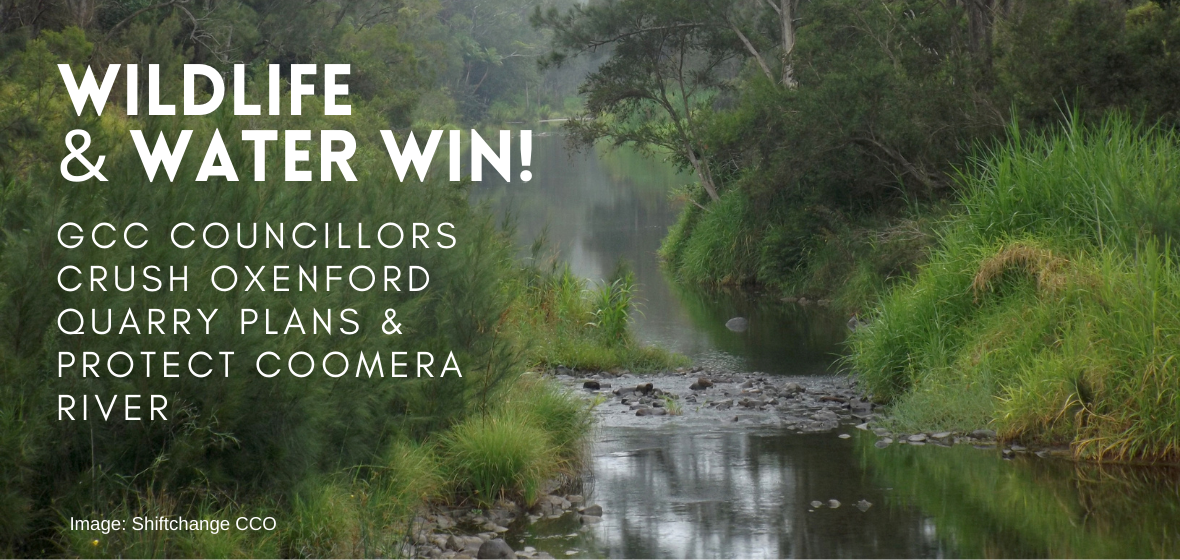2 December 2021
The dust gets worse year after year. The noise is unbearable at times. The blasting shakes the ground for vast distances all around. The drilling to sub 95 m (or more) will have unknown impacts on the water table and on groundwater-dependent ecosystems. The development application fails the State Planning Policy Key Resource Area (KRA) requirements for ‘transport route separation areas’. The proposal requires the unprecedented destruction of approximately 12.5 ha of environmentally significant vegetation and protected koala habitat. It also requires the destruction of a tributary to the Coomera River, despite its state and local area protection as an ‘Environmentally significant waterway’…
The litany of concerns above, many of which surrounding residents have lived with for decades, were all tabled to Gold Coast City Council as objections to the proposed Nucrush Pty Ltd development application to extend quarry operations at Oxenford, on Queensland’s Gold Coast, for a further 100 years. Thankfully, Wildlife Queensland’s Gold Coast and Hinterland Branch was not alone in recognising the danger of this long-term, environmentally and socially damaging proposal. In September, Gold Coast City Councillors voted 8 to 5 to reject the 100-year+ development application.
“We would like to thank everyone for their support, attendance at meetings, all the emails, text messages and phone calls,” says Wildlife Queensland’s Gold Coast Branch President Sally Spain.
“It has been a truly magnificent community effort. We would also like to thank Councillor William Owen-Jones for his eloquent, clear presentation to reject this ridiculous development application, supported by Councillor Peter Young, and all of the other Councillors who stood up for our environment and said no to the proposal.”
The quarry, which spews out dangerous respirable silica dust, had proposed to increase production from the earlier 350 000 tonnes per annum to a proposed one million tonnes per annum. Opponents pointed out that these levels factored in a TWA (time-weighted allowance) that set dust limits for workers only – typically young men working just eight hours a day and all wearing professional personal protection equipment (PPE). However, residents of all ages were being exposed to chronic 24/7 exposure. Noise modelling in the development application also revealed that from Stage 1 onwards sensitive environmental noise limits could not realistically be met.
Water Quality and Wildlife Corridors Were Major Concerns
Of particular concern to Wildlife Queensland was the proposal’s potential for extreme, irreversible environmental damage.
“The development application showed groundwater would leach through the pit walls and pit floor at 30 L per second,” explains Spain.
“Where would all this contaminated water – a volume far greater than required for the site to use – go? Well, the majority would have been pumped into the Coomera River, despite the Department of Environment’s Environmental Authority EA0002207 forbidding that and directing that only stormwater was permitted to leave the site.”
Buffer zones and wildlife connectivity were also overlooked by the proposal. State guidelines for blasting call for a 1000 m Blast Exclusion Zone (BEZ), whereas the Nucrush proposal suggested reducing that to just 160 m, in the process further constricting a vital wildlife corridor close to the Nerang State Forest, reducing it to an untenable width for wildlife. Information within the proposal application also ignored the clear intent of zoned areas and protected areas in the southwest in order to suggest the proposed footprint was comparable with the existing footprint when it clearly was not.
Opponents to the proposal tabled a long, but by no means exhaustive, list of City Plan requirements that the Nucrush Quarry development approval failed to meet.
“Let’s not forget that this development was for a proposed time scale of one hundred years plus – so obscenely long that it didn’t specify a finite year. That’s a proposal that would adversely affect four or five generations of Gold Coast residents and wildlife,” adds Spain.
The Dust-Up Continues …
The many flaws highlighted in the development application only scratch the surface of the residents’ concerns. While the council expects an appeal from Nucrush Pty Ltd that could draw on for years, past the original February 2022 end date of operations, with the quarry likely continuing to operate during mediation, for now, Sally Spain and the dedicated team at Wildlife Queensland’s Gold Coast Branch have the last word: “Rest assured that whatever happens, our community will continue to fight the extension of quarry operations at every step of the way.”

